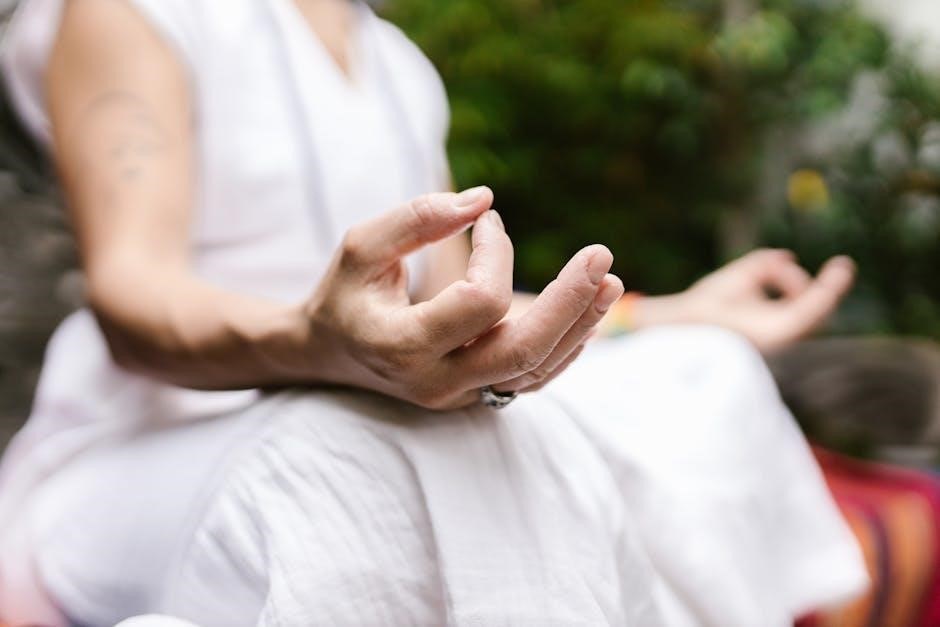
all hand mudras pdf
Hand mudras are ancient hand gestures used in yoga and meditation, originating from Hindu and Buddhist traditions. They regulate energy flow, balance the elements, and promote mental and physical well-being.
What Are Hand Mudras?
Hand mudras are ancient hand gestures used to regulate and balance the flow of energy in the body. Originating from Hindu and Buddhist traditions, these gestures involve specific positions of the fingers and hands to channel and harmonize life forces. Mudras are often referred to as “seals” or “locks” because they help contain and direct prana, or vital energy, within the body. Each mudra has a unique purpose, such as promoting physical health, mental clarity, or spiritual growth. By pressing or connecting specific fingertips, mudras influence the body’s energy pathways, or nadis, and the five elements (earth, water, fire, air, and space). Regular practice is believed to enhance well-being and create a deeper connection between the body, mind, and spirit.
Origin and Cultural Significance of Mudras
Hand mudras trace their origins to ancient Hindu and Buddhist traditions, where they were used as sacred gestures to convey spiritual and philosophical meanings. In Hinduism, mudras are associated with deities and rituals, symbolizing divine energy and cosmic forces. Buddhism adopted mudras to depict enlightenment and compassion, as seen in Buddha statues. These gestures are deeply rooted in the belief that the hands hold the power to influence the body’s energy and consciousness. Mudras are also integral to Indian classical dance and rituals, serving as a bridge between the physical and spiritual realms. Their cultural significance extends beyond religion, representing a universal language of self-expression and inner transformation, now embraced globally for their holistic benefits.
Mudras in Yoga and Meditation Practices

Mudras are integral to yoga and meditation, serving as powerful tools to balance the body’s energy and consciousness. By sealing specific finger and hand positions, mudras help regulate the flow of prana (life force) and harmonize the five elements within the body. In yoga, mudras are often practiced during asanas or breathing exercises to enhance their effects. In meditation, they act as focal points to quiet the mind and deepen awareness. Regular practice of mudras is believed to promote mental calmness, physical well-being, and spiritual growth. Combined with proper breathing techniques, mudras create a holistic practice that connects the body, mind, and spirit, fostering overall balance and inner harmony.

Types of Hand Mudras
Hand mudras are diverse, ranging from Hasta Mudras that regulate energy to specific gestures like Abhaya and Jnana Mudras, each offering unique benefits for balance and well-being.
Hasta Mudras: Hand Gestures for Energy Regulation
Hasta Mudras are intricate hand gestures that regulate the flow of prana (life force) in the body. By positioning fingers and thumbs in specific ways, these mudras balance the body’s energy and harmonize the elements. Examples include Abhaya Mudra for fearlessness, Jnana Mudra for knowledge, and Prana Mudra for vitality. These gestures are deeply rooted in yoga and meditation, offering benefits like improved focus, emotional stability, and physical well-being. Regular practice enhances energy circulation, promoting overall health and spiritual growth. Hasta Mudras are accessible to everyone, making them a powerful tool for holistic wellness.
Abhaya Mudra: The Gesture of Fearlessness
The Abhaya Mudra is a powerful hand gesture symbolizing fearlessness and protection. Often depicted in Buddhist art, it involves extending the right hand with the palm facing outward and fingers straight. This mudra is believed to ward off negative energies, instill courage, and provide a sense of safety. Practiced in yoga and meditation, it helps cultivate emotional stability and confidence. By embracing this gesture, one can overcome fear and anxiety, fostering a calm and resilient mindset. Its simplicity makes it accessible to everyone, allowing individuals to connect with its profound benefits and experience inner peace. Regular practice enhances emotional well-being and spiritual growth.
Jnana Mudra: The Gesture of Knowledge
The Jnana Mudra, or the Gesture of Knowledge, is a profound hand gesture that enhances mental clarity and spiritual awareness. It is performed by touching the tip of the thumb to the index finger, forming a circle, while extending the other fingers. This mudra is believed to activate the energies of knowledge and intuition, fostering a deeper connection to one’s inner wisdom. Regular practice improves concentration, memory, and problem-solving skills. It is often used in meditation to quiet the mind and access higher states of consciousness. Rooted in Buddhist and Hindu traditions, Jnana Mudra symbolizes the union of the individual self with universal knowledge, promoting enlightenment and self-realization. Its simplicity makes it a popular choice for both beginners and advanced practitioners seeking mental and spiritual growth.

Chin Mudra: The Gesture of Consciousness
The Chin Mudra is a powerful hand gesture that connects the thumb and index finger, symbolizing the unity of individual consciousness with universal consciousness. This mudra is often practiced during meditation to enhance focus, calm the mind, and promote spiritual awareness. By touching the thumb to the index finger, it activates the energies associated with knowledge and intuition, fostering a deeper sense of inner peace. Regular practice of Chin Mudra is believed to improve mental clarity, reduce stress, and cultivate a sense of oneness with the universe. It is widely used in yoga and meditation practices to elevate consciousness and bring balance to the body and mind. This gesture is simple yet profound, making it accessible to practitioners of all levels.
Prana Mudra: The Gesture of Life Force
Prana Mudra is a hand gesture that symbolizes the vital energy or life force within the body. It involves touching the thumb to the ring and little fingers while extending the other fingers. This mudra is believed to enhance the flow of prana, the life-giving energy, and promote overall vitality. By activating the energy centers in the body, Prana Mudra helps balance the elements, improve respiratory health, and boost immunity. Regular practice is said to increase energy levels, reduce fatigue, and foster a sense of well-being. It is often recommended for those seeking to revitalize their body and mind, making it a popular choice in yoga and meditation practices aimed at rejuvenation and spiritual growth. This gesture is simple yet effective, offering profound benefits for both physical and mental health.

Common Hand Mudras and Their Benefits
Common hand mudras like Gyan, Varada, Apana, Vayu, Akasha, Prithvi, Jal, and Agni Mudra offer unique benefits, such as improving knowledge, granting wishes, aiding digestion, balancing air, enhancing hearing, stabilizing energy, promoting fluidity, and transforming negativity into positivity.
Gyan Mudra: The Gesture of Knowledge
Gyan Mudra, or the Gesture of Knowledge, is a powerful hand mudra that enhances memory, concentration, and mental clarity. It is performed by touching the tip of the thumb and index finger, symbolizing the connection of the individual self with universal consciousness. This mudra is known to reduce stress, improve learning abilities, and foster a sense of calmness. Regular practice of Gyan Mudra is believed to activate the root chakra, promoting emotional stability and spiritual growth. It is often recommended for students, intellectuals, and anyone seeking mental clarity and inner peace. By balancing the air element in the body, Gyan Mudra also supports respiratory health and overall well-being.
Varada Mudra: The Gesture of Granting Wishes
Varada Mudra, or the Gesture of Granting Wishes, is a sacred hand mudra symbolizing compassion and blessings. It is often depicted in Buddhist art, where the right hand extends downward with the palm facing outward and fingers relaxed. This mudra embodies the act of granting wishes, fostering a sense of generosity and positivity. Practicing Varada Mudra is believed to cultivate emotional balance, reduce stress, and enhance feelings of gratitude. It is also associated with the heart chakra, promoting love and harmony. Regular practice of this mudra is said to attract positive energy and manifest desires, making it a powerful tool for spiritual and emotional well-being. It is often combined with meditation to deepen its effects and connect with divine grace.
Apana Mudra: The Gesture of Digestion and Grounding
Apana Mudra, or the Gesture of Digestion and Grounding, is a powerful hand mudra that aids in balancing the digestive system and promoting overall well-being. It is formed by gently touching the tip of the thumb to the tips of the middle and ring fingers, while extending the index and little fingers. This mudra is believed to enhance the flow of apana vata, the downward-moving energy in the body, which governs digestion, elimination, and grounding. Regular practice of Apana Mudra is said to improve digestive health, reduce stress, and create a sense of stability. It is also known to help in detoxifying the body and fostering emotional calmness. This mudra is particularly beneficial for individuals seeking to restore balance to their digestive and nervous systems.
Vayu Mudra: The Gesture for Balancing Air
Vayu Mudra, or the Gesture for Balancing Air, is a hand mudra designed to harmonize the air element (Vata) in the body. It is performed by gently placing the tip of the thumb onto the tip of the pinky finger, while extending the other fingers. This gesture is believed to regulate the flow of Vayu, the vital air energy, which governs respiratory and nervous system functions. Regular practice of Vayu Mudra is said to alleviate respiratory disorders, such as asthma and allergies, and improve overall vitality. It also helps to calm the mind, reduce stress, and promote a sense of lightness and clarity. This mudra is particularly beneficial for individuals with air-related imbalances or those seeking to enhance their breathing practices.
Akasha Mudra: The Gesture of Space and Hearing
Akasha Mudra, or the Gesture of Space and Hearing, is a hand mudra that connects to the element of ether (Akasha). It is performed by gently pressing the tip of the thumb against the tip of the middle finger, forming a circle. This gesture symbolizes the infinite and boundless nature of space and consciousness. Practicing Akasha Mudra is believed to enhance hearing, improve balance, and reduce ear-related issues. It also supports meditation by quieting the mind and fostering a sense of inner calm. Additionally, this mudra is associated with the fifth chakra, which governs communication and self-expression, making it a powerful tool for spiritual growth and emotional harmony. Regular practice can deepen one’s connection to the subtle energies of the universe.

Prithvi Mudra: The Gesture of Earth and Stability
Prithvi Mudra, the Gesture of Earth and Stability, is a powerful hand mudra that connects to the earth element. It is performed by touching the tip of the ring finger to the tip of the thumb, while extending the other fingers. This gesture is believed to enhance grounding, stability, and emotional balance. It strengthens the connection to the physical body and promotes a sense of calm and rootedness. Regular practice of Prithvi Mudra is said to improve vitality, reduce stress, and support overall well-being. It is particularly beneficial for individuals seeking to cultivate resilience and stability in their lives. This mudra is also associated with healing properties that nourish the body and mind, fostering a deeper sense of harmony and equilibrium.
Jal Mudra: The Gesture of Water and Fluidity
Jal Mudra, the Gesture of Water and Fluidity, is a hand mudra that embodies the qualities of water, fostering emotional balance and fluidity in the body. To perform Jal Mudra, the tip of the little finger is gently touched to the tip of the thumb, while the other fingers remain extended. This gesture is believed to enhance the flow of water energy in the body, promoting hydration, cooling, and relaxation. Regular practice of Jal Mudra is said to improve memory, reduce stress, and balance emotions. It is also known to support the immune system and address respiratory issues. By harmonizing the water element, Jal Mudra helps in maintaining physical and mental well-being, encouraging a calm and adaptable nature.
Agni Mudra: The Gesture of Fire and Transformation
Agni Mudra, or the Gesture of Fire and Transformation, is a powerful hand mudra that embodies the element of fire. It is performed by touching the tip of the thumb to the tip of the ring finger, while extending the other fingers. This gesture is believed to ignite the inner fire, promoting digestion, metabolism, and energy. Agni Mudra is known to enhance vitality, improve circulation, and purify the body by stimulating the digestive system. It also helps in reducing excess body heat and addressing issues like indigestion. By fostering transformation and renewal, Agni Mudra supports both physical and mental well-being, encouraging passion, clarity, and motivation. Regular practice can lead to a balanced and energized state of being.
How to Practice Hand Mudras
To practice hand mudras, sit comfortably in a quiet space, ensuring your hands are clean. Hold each mudra for 5-30 minutes, ideally during meditation or deep breathing. Consistency enhances their benefits.
Preparation for Mudra Practice

To prepare for hand mudra practice, find a quiet and clean space free from distractions. Sit comfortably in a meditative posture, such as cross-legged or on a chair, with your back straight. Ensure your hands are clean and dry, as they are the focal point of the practice. Wear loose, comfortable clothing that allows free movement of your arms and hands. Before starting, take a few deep breaths to calm your mind and center your energy. Begin with simple mudras to warm up your hands and fingers, gradually moving to more complex gestures. Consistency and patience are key to experiencing the full benefits of mudra practice. Regular preparation enhances the effectiveness of the gestures.
Duration and Frequency of Mudra Practice
The duration and frequency of hand mudra practice vary depending on the individual’s goals and experience level. Beginners can start with 5-10 minutes daily, gradually increasing to 15-30 minutes as they become more comfortable. For specific benefits, such as balancing the elements or enhancing meditation, consistent practice is key. Aim to practice mudras 3-4 times a week, ideally at the same time each day to establish a routine. Advanced practitioners may extend their sessions or incorporate mudras into daily activities like meditation or yoga. It’s important to listen to your body and adjust the duration and frequency based on how you feel. Regular and focused practice yields the best results for physical, mental, and spiritual well-being. Consistency is essential for experiencing the full benefits of mudras.
Combining Mudras with Breathing Techniques

Combining hand mudras with breathing techniques enhances their effectiveness, promoting energy flow and balance. Different mudras correspond to elements like air, fire, and water, each paired with specific breath patterns. For example, Vayu Mudra (air) involves the index finger and thumb, paired with slow, deep breathing to balance air elements. Anuloma Viloma (alternate nostril breathing) is often used with mudras to prepare the body for meditation. Synchronization of breath and mudra intensifies the practice, aiding in energy regulation and spiritual growth. This combination is particularly beneficial for awakening kundalini energy and achieving a balanced state. Regular practice supports overall well-being and deepens meditative experiences.

Advanced Hand Mudras and Their Techniques
Advanced hand mudras involve intricate finger placements and techniques to enhance spiritual growth and energy balance, often used in Kundalini Yoga and chakra balancing practices.
Complex Hand Gestures for Spiritual Growth
Complex hand mudras are advanced techniques that combine intricate finger placements and breath control to deepen spiritual practice. These gestures, often used in Kundalini Yoga, aim to awaken dormant energy and balance the chakras. By sealing specific flows of prana, they enhance meditation and promote higher states of consciousness. Mudras like the Kundalini mudra and others involve precise alignments of the hands and fingers to channel energy upward, fostering spiritual awakening. Regular practice of these gestures can lead to profound inner transformation, aligning the body, mind, and spirit. They are particularly effective when paired with breathing techniques and visualizations, amplifying their spiritual impact. These advanced mudras are a powerful tool for those seeking deeper enlightenment and self-realization;
Mudras for Chakra Balancing
Mudras play a vital role in balancing the seven chakras, or energy centers, in the body. Each chakra corresponds to specific fingers and thumb placements, which influence the flow of prana. For instance, the thumb represents fire, the index finger air, the middle finger ether, the ring finger earth, and the little finger water. By practicing mudras like Prana Mudra, Apana Mudra, and Surya Mudra, one can align and harmonize the chakras. Regular practice helps in awakening dormant energy, enhancing spiritual growth, and promoting overall well-being. These gestures, when combined with breathing techniques, amplify their effects, leading to a balanced and centered state of being. Mudras are thus a powerful tool for chakra balancing and holistic health.
Using Mudras in Kundalini Yoga

In Kundalini Yoga, mudras are integral to awakening and balancing the energy within the body. They are often practiced alongside postures, breathwork, and mantras to intensify their effects. Specific gestures, such as bringing the thumb and index finger together or extending the ring finger, are believed to channel and direct the flow of Kundalini energy. These mudras help activate the chakras, particularly the navel and crown centers, facilitating spiritual awakening. Kundalini expert Lothar-Riidiger emphasizes their role in enhancing meditation and promoting self-awareness. By combining mudras with breathing techniques, practitioners can experience profound shifts in consciousness, leading to emotional, mental, and spiritual transformation. This ancient practice continues to inspire modern yogis seeking holistic well-being and inner harmony.
Hand mudras offer a timeless practice to balance energy, enhance meditation, and promote physical and mental well-being. Their simplicity and profound benefits make them accessible for modern life.
The Importance of Hand Mudras in Modern Life
Hand mudras are increasingly valued in modern life for their holistic benefits. By regulating energy flow and balancing the elements, they offer a natural way to reduce stress and enhance well-being. In today’s fast-paced world, these gestures provide a simple yet powerful tool for mental and physical harmony. Regular practice can improve focus, emotional stability, and overall health, making mudras a timeless and practical solution for contemporary challenges. Their accessibility and effectiveness have made them a popular choice for those seeking balance in busy lifestyles.
Final Thoughts on Incorporating Mudras into Daily Practice
Incorporating hand mudras into daily life is a simple yet profound practice that offers numerous benefits. These gestures are accessible to everyone, requiring no special equipment or extensive training. Regular practice can lead to improved emotional balance, reduced stress, and enhanced physical well-being. Mudras also foster mindfulness and connection to one’s inner self, making them a valuable addition to meditation and yoga routines. Consistency is key, as even a few minutes each day can yield positive results. By embracing mudras, individuals can experience holistic health and a deeper sense of harmony in their lives. This ancient practice remains a timeless tool for modern wellness.